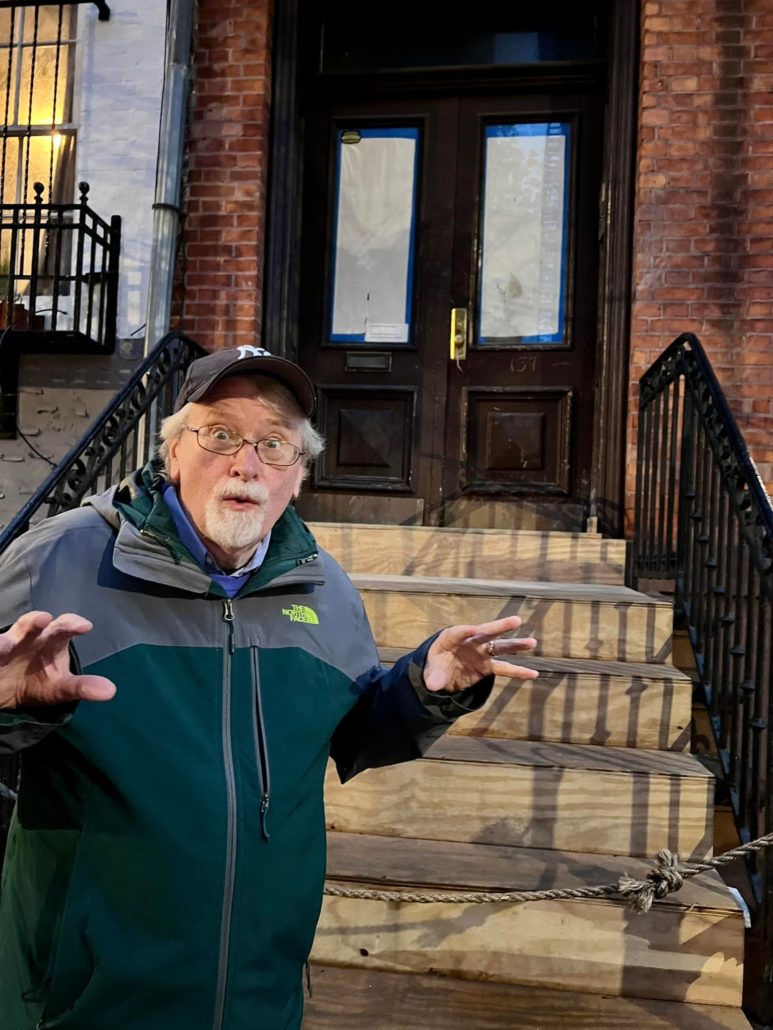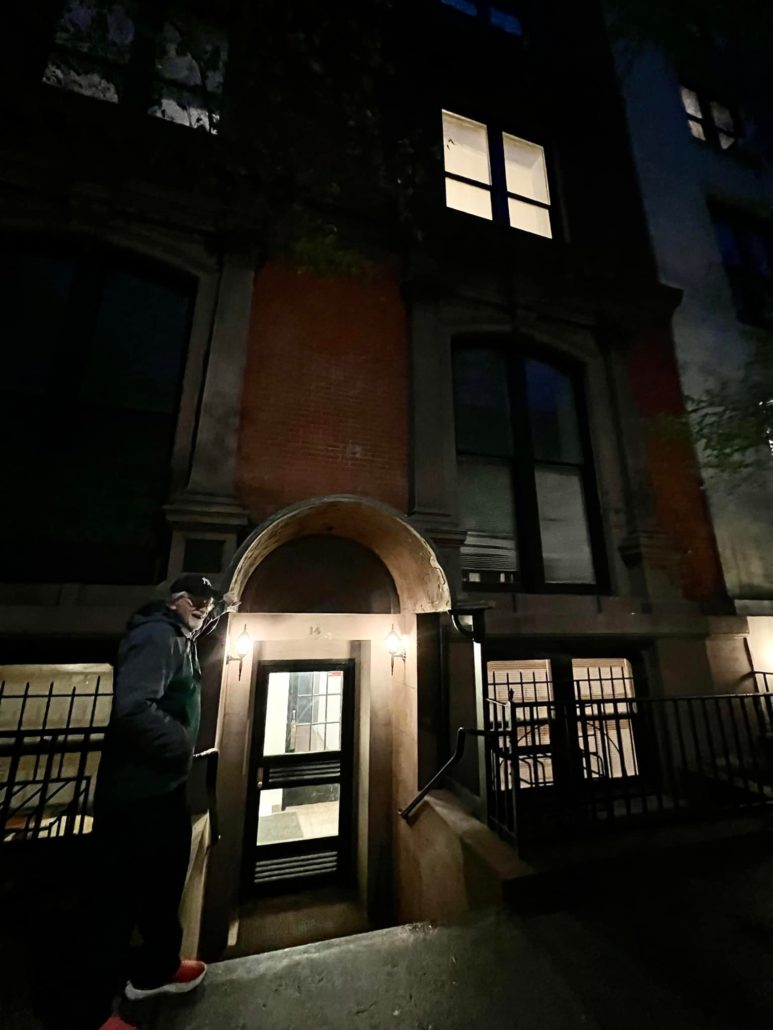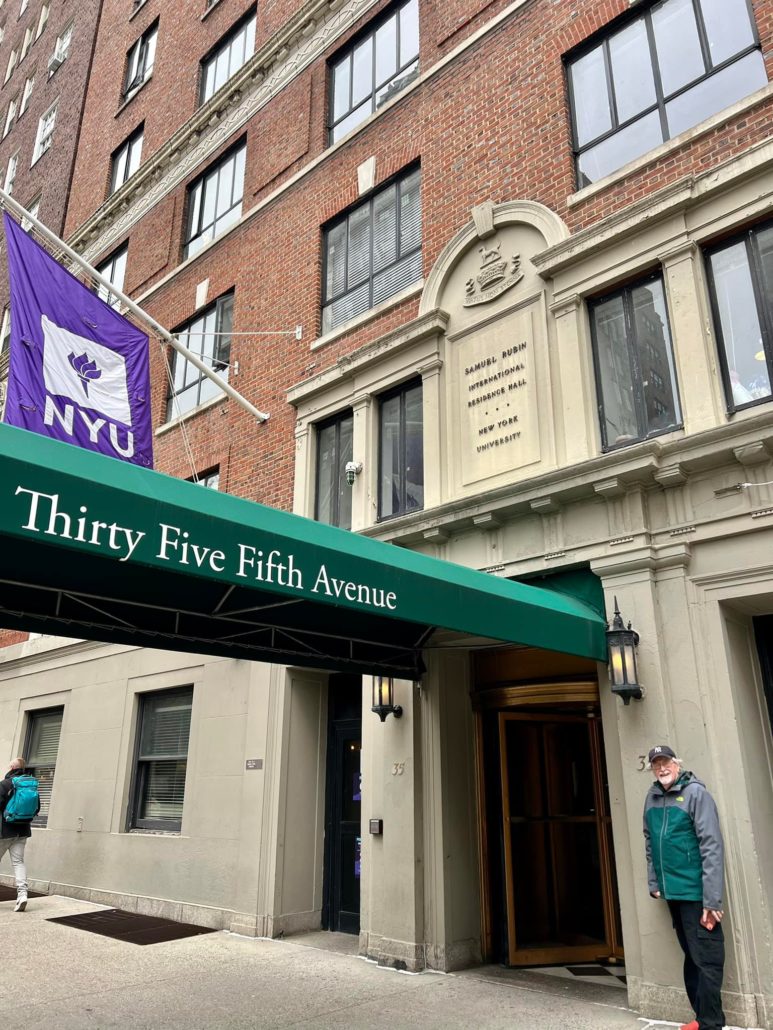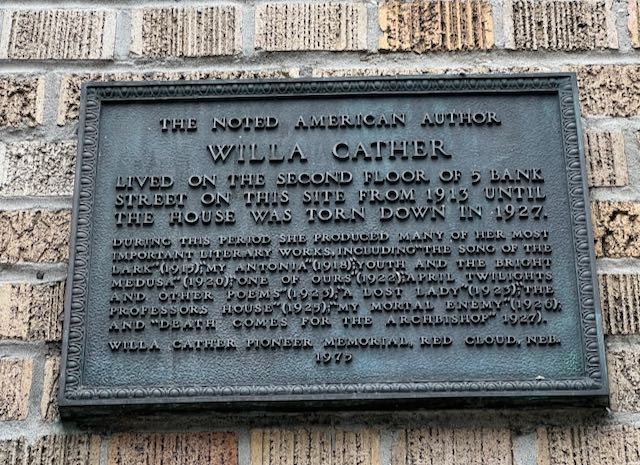We had come to the front door of an upscale apartment house at 29 East Ninth Street in Greenwich Village, to visit our Instagram friends Tony and Stephanie, whom we had bonded with over our dogs. We were there to meet their new collie, and as I glanced to the right of the door, I noticed the prominent plaque there honoring Terrence McNally, the prolific and acclaimed playwright who had, apparently, lived in the building for years before becoming the first significant Broadway figure to die from COVID-related complications on March 24, 2020.
McNally won four Tony Awards in his career—two for Best Play (for Love! Valour! Compassion! and Master Class) and two for Best Book of a Musical (for Kiss of the Spider Woman and Ragtime)—plus a special Lifetime Achievement Tony in 2019, which he ironically joked had come “Not a moment too soon.”
McNally first came to New York in 1956 to attend Columbia, and soon became the partner of Edward Albee, then reaching the peak of his career, and they lived together in the Village in Abingdon Square Park. His own first success came with And Things That Go Bump in the Night in 1965. Over the next 50 years he wrote three dozen plays, the books for ten musicals, librettos for four operas, plus a few screenplays for film and television.
His death during the COVID pandemic made it impossible to honor him as the city would have liked, but on November 3, 2021, on what would have been his 82nd birthday, New York proclaimed Terrence McNally Day, and the Historic Landmarks Preservations Center honored his life and work with a celebration—and plaque—on the sidewalk outside this apartment building, where he had lived with his long-time companion and ultimately husband, Broadway producer Tom Kirdahy (who, it turns out, had been a college classmate of our friend Tony, who reconnected with him when they ran into each other in the hallway of their building).
Late in his life, McNally lamented the fact that in his early days, upcoming writers would make a home in Greenwich Village. But now prices had gone up so much that they had to live in Brooklyn or the Bronx. Seeing that plaque on that East Ninth Street house, though, led me to wonder what other literary icons had lived in the neighborhood. The answer was in my phone, which gave me a long list of authors’ one-time homes in the Village.

The house at 137 Waverly Place is traditionally claimed to have been Edgar Allan Poe’s first home in New York when he moved to the city with his wife and mother-in-law in 1844. He is known to have lived in New York for the last five years of his life, although I found after a little digging that there is no actual proof that he lived at this particular address. There are only two houses in New York that can be verified as Poe’s one-time homes: One is further downtown from this one at 85 West Third Street and the other is a cottage in the Bronx in the neighborhood of Fordham, where he lived until his death in 1849. It was in that cottage that his wife Virginia (his cousin whom he had married when she was 13 and he 26) died after a five-year battle with tuberculosis in 1847 while still in her 20s. The consumptive Virginia is often thought to be the inspiration for the frail “beauty that must die” women who people his poems and short stories. Indeed, the well-known “lost Lenore” of the Raven was born here in New York in 1845.
Of course, she was probably born in that house on West Third Street, where the poet and his Virginia were known to be living from 1844 to 1846. Unfortunately, that house was torn down in 2001 and is now a part of NYU’s Furman Hall. There’s a plaque there, but not much else. But Poe is known to have lived in several houses in New York, so maybe this one on Waverly really was one of them, as legend claims. So if you want to pay your respects to the father of the detective story, the first theorist of the short story, the inspiration of the French symbolist poets, and the first major American writer to make his living solely by his pen, you might as well come to this house and pretend to believe the legend.

America’s most beloved writer, Mark Twain, famously died in his fine house near Hartford, Connecticut, where he lived next door to Harriet Beecher Stowe. However, the creator of Tom Sawyer and Huck Finn did reside in New York for a good part of his later life. In 1900, at the age of 64, he moved into a brownstone at 14 West Tenth Street in Greenwich Village. When Twain moved here, he was in a state of depression after the death of his daughter Suzy from meningitis in 1896. He had most recently published his uncharacteristically sincere novel on the life of Joan of Arc, which, despite unfavorable reviews, he always insisted was his best work. He was working on his final novel, The Mysterious Stranger, which his wife Olivia disliked because of its anti-religious elements. And, in 1901, he gave a significant speech in favor of women’s suffrage, and wrote a scathing criticism of Western imperialism in China.
But Twain only lived here until 1901 then moved to another New York address. He lived in the Village again from 1904 to1908 in a long-demolished stately four-story home at 21 Fifth Avenue, on the corner of Ninth Street, before moving to Connecticut. Maybe he was driven out by the ghosts.
Indeed, this house has been called New York’s “House of Death.” Since its construction in the 1850s, at least 22 residents are known to have died in this house, the most infamous occurring in November of 1987, when a former attorney named Joel Steinberg beat to death the six-year-old daughter of his partner. Prior to that, the author Jane Bryant Bartell lived in the house with her husband in 1957, and wrote in a later memoir of strange paranormal activity on the premises. The couple reportedly hired a medium, who supposedly found in the house the spirit of an aborted baby and her nineteen-year-old mother, Reenie Mallison, who was born, according to the medium, in 1848.
More to the point, I suppose, is the report from the 1930s from a mother and daughter who were residents of the house, who claimed to have seen Twain himself haunting the premises. Reportedly, he was sitting near a window in his signature white suit, and told them “My name is Clemens, and I has a problem here I gotta settle.”

We usually associate Willa Cather with the Great Plains of Nebraska because of her novels like My Antonia and The Song of the Lark. But Cather came to New York in 1906 to work as editor of McClure’s Magazine, and lived here until she died in 1947. By then she was living on Park Avenue, but she lived in four different places in Greenwich Village earlier in her career. She lived briefly at 60 Washington Square South, then in 1909 moved to a new place at 82 Washington Place with Edith Lewis, a proofreader at McLure’s who became her lifelong partner.

We visited Cather’s other two Village addresses: 5 Bank Street, where she and Lewis lived from 1913 until 1927, and where she spent her most productive years, writing The Song of the Lark, My Antonia, and Death Comes for the Archbishop, as well as other works in this house. The place was torn down in 1927 and replaced with an apartment building, but there’s a memorial plaque at the address. When forced to leave Bank Street, Cather and Lewis moved to the Grosvenor Hotel at 35 Fifth Avenue, on the corner of Tenth Street, where they lived for five years before moving uptown. This hotel is now an NYU residence hall.

Norman Mailer was a very visible resident of Greenwich Village. He and three friends started The Village Voice in 1955, the same year he published his third novel, The Deer Park. He had moved to the Village in 1951 with his mistress Adele Morales, who in 1954 became the second of his six wives, and the couple moved into the house at 73 Perry Street in 1958.
It was here that, after throwing a party on November 19, 1960, Mailer stabbed Adele twice with a two-and-one-half-inch penknife—once in the chest and once in the back. Adele was rushed to the hospital with her pericardium punctured and nearly died, but recovered after emergency surgery. Mailer said that he had stabbed his wife “to relieve her of cancer,” and was subsequently committed to Bellevue Hospital for 17 days. Adele refused to press charges, and Mailer pled guilty to a reduced charge of assault, receiving a suspended sentence and three years’ probation. Two years later Adele divorced Mailer, and in 1997 published a memoir called The Last Party, in which she described the stabbing. Meanwhile Mailer went on to win two Pulitzer Prizes and become the only writer with a best-selling book in each of the seven decades following World War II.

W. H. Auden, widely considered one of the three greatest English-language poets of the modern period, and called by Nobel laureate Joseph Brodsky “the greatest mind of the twentieth century,” moved to the United States in 1939, becoming a citizen in 1946. He lived in Brooklyn Heights for the first dozen or so years, but lived from 1953 to 1972 in the East Village with his collaborator and one-time lover Chester Kalman. The second floor apartment at 77 St. Mark’s Place was reputedly a ramshackle place: The famous political philosopher Hannah Arendt is purported to have said that during the winter, the apartment would become so cold that Auden would have to use the toilet at the liquor store down the street because his own had frozen. Still, he seems to have had a fondness for the place, and when he decided to give it up and return to England in 1972, he wrote that New York “is not simply a metropolis: It is also a city of neighborhoods, and I consider myself extremely fortunate in the one where I have lived for the past twenty years.”
In 1982, a commemorative plaque was put on the building, but it was apparently stolen in 1997 and has never been replaced. Still, you shouldn’t have any trouble finding it: The building now houses a Mexican restaurant, La Palapa.
This post is becoming quite long. Of course, there are dozens of other authors’ residences and literary sites in the Village. James Baldwin lived at 81 Horatio Street, William S. Burrows at 69 Bedford Street, John Cheever at 76 and John Dos Passos at 11 Bank Street, William Styron at 45 Greenwich Avenue, Edna St. Vincent Millay at 75½ Barrow Street, Hart Crane at four different addresses in the Village. Henry James lived at 11 Fifth Avenue, a site that was demolished and is now a hotel. Robert Frost is purported to have lived at 107 Waverly Place, but I’ve found nothing to verify that. e.e. cummings lived at No. 4 in the gated Patchin Place for the last 40 years of his life. If you want to find the place where Dylan Thomas allegedly drank himself to death in 1953, it’s at the White Horse Tavern at the corner of 11th and Hudson. And, of course, the list goes on and on. And then there’s Edith Wharton…but I think we’ll have to save that one for another time.

